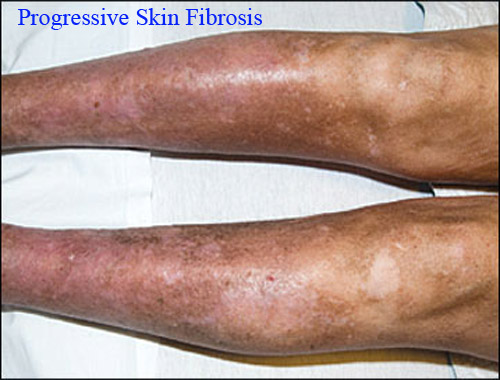Fibrosis

Published: 18 Jun 2025
ICD9: 515 ICD10: J84.10 ICD11: 2F23
Fibrosis is the formation of excess fibrous connective tissue in an organ or tissue in a reparative or reactive process.
Think of it as excessive scarring inside the body.
Here's a breakdown:
![]() Fibrous connective tissue: This is a type of tissue that provides structural support and strength. Collagen is a key component.
Fibrous connective tissue: This is a type of tissue that provides structural support and strength. Collagen is a key component.
![]() Reparative/Reactive process: This means it happens as a response to injury, inflammation, or other damage. The body attempts to heal itself, but sometimes it overdoes it.
Reparative/Reactive process: This means it happens as a response to injury, inflammation, or other damage. The body attempts to heal itself, but sometimes it overdoes it.
![]() Excessive: The key word here is "excess." Some fibrous tissue is normal and necessary. Fibrosis is when there's *too much*.
Excessive: The key word here is "excess." Some fibrous tissue is normal and necessary. Fibrosis is when there's *too much*.
![]() Organ or Tissue: Fibrosis can occur in almost any organ in the body, including the lungs, liver, heart, kidneys, skin, and more.
Organ or Tissue: Fibrosis can occur in almost any organ in the body, including the lungs, liver, heart, kidneys, skin, and more.
In simpler terms:
When an organ or tissue is damaged, the body tries to fix it. It lays down collagen (a strong, structural protein) to help repair the damage. However, sometimes the body goes overboard and lays down too much collagen, leading to a buildup of scar tissue. This scar tissue can interfere with the normal function of the organ.
Causes of Fibrosis:
Fibrosis can be caused by a variety of factors, including:
![]() Chronic inflammation: Long-term inflammation, often due to autoimmune diseases, infections, or exposure to toxins.
Chronic inflammation: Long-term inflammation, often due to autoimmune diseases, infections, or exposure to toxins.
![]() Injury: Physical trauma or surgery.
Injury: Physical trauma or surgery.
![]() Infection: Certain infections can trigger fibrosis.
Infection: Certain infections can trigger fibrosis.
![]() Genetic factors: Some people are genetically predisposed to developing fibrosis.
Genetic factors: Some people are genetically predisposed to developing fibrosis.
![]() Autoimmune diseases: such as systemic sclerosis.
Autoimmune diseases: such as systemic sclerosis.
![]() Environmental factors: Exposure to certain toxins or pollutants.
Environmental factors: Exposure to certain toxins or pollutants.
Effects of Fibrosis:
The effects of fibrosis depend on the organ or tissue affected. Generally, fibrosis leads to:
![]() Stiffening of the tissue: The excess collagen makes the tissue less flexible.
Stiffening of the tissue: The excess collagen makes the tissue less flexible.
![]() Impaired function: The scar tissue disrupts the normal structure and function of the organ.
Impaired function: The scar tissue disrupts the normal structure and function of the organ.
![]() Organ failure: In severe cases, fibrosis can lead to organ failure.
Organ failure: In severe cases, fibrosis can lead to organ failure.
Examples of Fibrotic Diseases:
![]() Pulmonary fibrosis: Fibrosis of the lungs, making it difficult to breathe.
Pulmonary fibrosis: Fibrosis of the lungs, making it difficult to breathe.
![]() Liver cirrhosis: Fibrosis of the liver, often caused by alcohol abuse or viral hepatitis.
Liver cirrhosis: Fibrosis of the liver, often caused by alcohol abuse or viral hepatitis.
![]() Kidney fibrosis: Fibrosis of the kidneys, leading to kidney failure.
Kidney fibrosis: Fibrosis of the kidneys, leading to kidney failure.
![]() Systemic sclerosis (scleroderma): Fibrosis of the skin and internal organs.
Systemic sclerosis (scleroderma): Fibrosis of the skin and internal organs.
![]() Myocardial fibrosis: Fibrosis of the heart muscle.
Myocardial fibrosis: Fibrosis of the heart muscle.
Treatment:
There is no cure for fibrosis. Treatment typically focuses on:
![]() Addressing the underlying cause: If possible, treating the underlying inflammation or injury.
Addressing the underlying cause: If possible, treating the underlying inflammation or injury.
![]() Slowing the progression of fibrosis: Medications and lifestyle changes can help slow the rate of scarring.
Slowing the progression of fibrosis: Medications and lifestyle changes can help slow the rate of scarring.
![]() Managing symptoms: Medications and therapies can help alleviate the symptoms of fibrosis.
Managing symptoms: Medications and therapies can help alleviate the symptoms of fibrosis.
![]() Organ transplantation: In severe cases, organ transplantation may be necessary.
Organ transplantation: In severe cases, organ transplantation may be necessary.
In summary, fibrosis is a serious condition that can affect any organ in the body. It is characterized by the excessive formation of scar tissue, which can lead to impaired organ function and ultimately organ failure. Treatment options are limited, but there are ways to slow the progression of the disease and manage its symptoms.